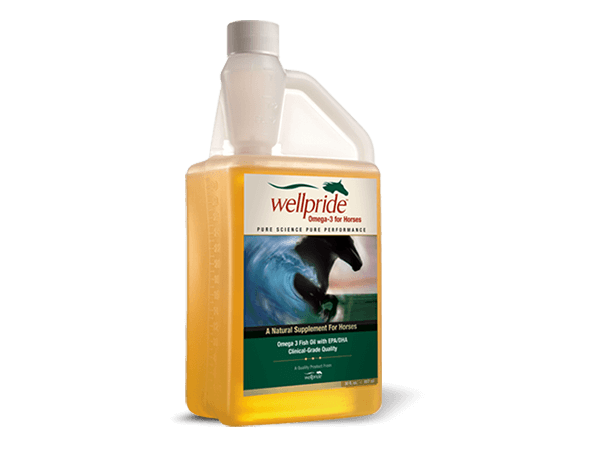How to Boost Your Breeding Stock’s Reproductive Health
It’s that time of year again. The time when horse breeders make management changes for their mares and stallions in preparation for the beginning of breeding season.
Breeding horses can be a complicated process, and mares don’t always get in foal the first time around. However, there is a way to boost mare and stallion fertility. Studies have shown that feeding omega-3s to both stallions and mares can have promising results. Below we look at the effects that adding omega-3 supplements can have on your breeding stock’s reproductive health.
Stallion Fertility
Semen consists of significant amounts of fatty acids, the majority coming from both the omega-3 and omega-6 families. The balance between these fatty acid families, as well as the types of omega-3s present in the semen, can have a direct impact on fertility. Studies in other species, such as boars, have shown that a high ratio of omega-6 to omega-3 will result in reduced fertility. Similarly, human semen with lower levels of the omega-3 docosahexaenoic acid (DHA), a fatty acid found in fish oil, have also shown reduced fertility.
In horses, research indicates that supplementing with DHA will improve both sperm quality and quantity. Because DHA improves the sperm’s cell membrane, it allows the sperm to withstand the rigors of cooling and freezing for shipment. This is especially helpful for those stallions whose sperm is susceptible to cold (1).
One 2015 study at the University of Kentucky investigated omega-3 supplementation on 12 stallions. The stallions were fed either a control diet of grass hay and concentrates or the same diet with 15 grams of DHA for 60 days. The researchers found an increase of total sperm motility for stallions fed the DHA diet after the sperm had been cooled. In addition, progressive motility increased in the sperm of the DHA-fed stallions, but not in controls (2).
This study supported earlier conclusions made by researchers from Texas A&M University in 2008. In that study, researchers concluded that supplementing with omega-3 could be beneficial in increasing the post-thaw progressive motility of sperm (3).
Additional studies from Colorado State University, the University of Arizona, and Texas A&M have also shown an improvement in sperm output and semen quality. Colorado State University showed an increase in the total number of motile sperm by evaluating fresh, cooled, and frozen semen. Another study also showed an increase in the percentage of morphologically normal sperm and an increase in the semen concentration.
How Do Omega-3s and Omega-6s Work?
This video, while focused on human health, explains the interaction between the fatty acid families.
Mare Fertility
Getting a mare pregnant and maintaining the pregnancy can sometimes be frustrating for breeders. One reason is persistent mating-induced endometritis, an inflammatory condition affecting the lining of the uterus.
After mating, the body should normally respond by clearing the reproductive system of contaminants, excess sperm, and seminal plasma. However, if a mare fails to clear the uterus of inflammatory byproducts and fluids related to mating within 48 hours, the uterus can become inflamed. The chronic inflammation creates an environment that’s hostile to embryo survival. Unfortunately, this condition can be quite common in mares.
Omega-3 supplementation has been shown to inhibit the production of cytokines, which are chemicals involved with creating inflammation. A 2014 study using omega-3 supplements demonstrated a reduced inflammatory response in mares bred with frozen semen (4). Another study examined the amount of uterine fluid that remained in mares 24 hours after live cover. The mares fed with omega-3 fatty acids were less likely to have uterine fluid (23%) compared to the mares in the control group (50%). In addition, the supplemented mares had a significantly lower per cycle pregnancy rate compared to the control group.
Besides being important for reducing inflammation in the uterus, omega-3 supplementation can be important for improving the per cycle pregnancy rate of mares, meaning that she needs to cycle fewer times before becoming pregnant. In one study, 46 Thoroughbred mares were divided between a control group and a group fed 14.4 grams of omega-3 fatty acids. After 60 days of supplementation, the mares that were supplemented with omega-3 had a mean per cycle pregnancy rate of 1.19 versus the control group at 1.59 (5).
Many breeders who rebreed foaling mares want to ensure they become pregnant on the first cycle, also known as foal heat. The cycle typically occurs six to eight days after the foal is born.
In other species of livestock, supplementing omega-3 fatty acids has been shown to increase follicle size and oocyte viability, as well as improve embryo quality and survival. Looking at horses, researchers wanted to determine if supplementation would increase blood flow to reproductive tissues in the post-foaling mare. They also wondered if it would help with uterine involution, which is the process of the uterus returning to its pre-pregnancy size and condition. In the study, 20 stock breed mares were either put in a control group or a group supplemented with DHA for 90 days before the expected foaling date. Supplemented mares did indeed exhibit a faster rate of involution and increased blood flow in the ovarian artery that was directing blood to a dominant follicle leading up to the foal heat.
Considering the Source
These studies are just a small sampling of the research that has been done over the past 20 years. And looking at the data, it’s easy to see that supplementing breeding horses with omega-3s can provide a plethora of reproductive health benefits.
It’s important to note, however, that not all omega-3 supplements contain the same fatty acid makeup.Flax and other plant-based sources only provide alpha-linolenic acid (ALA), which needs to be converted in the body to deliver full benefits. Algal sources exclusively provide DHA. And fish oil delivers a full range of omega-3 fatty acids, including DHA, eicosapentaenoic acid (EPA), ALA and several other omega-3 varieties.
If you are considering omega-3 supplements for your breeding stock, check the supplement’s nutrition facts to see exactly what kinds of omega-3s it provides.

References:
1. Elhordoy, D.M., N. Cazales, G. Costa, J. Estevez. 2008. Effect of dietary supplementation with DHA on the quality of fresh, cooled, and frozen stallion semen. Journal of Animal Reproduction Science. 107(3-4):319.
2. Goedde, L.D., K.M. Brennan, B.A. Ball, L.M. Lawrence, M.H. Troedsson, E.L. Squires. 2015. Effects of feeding a yeast-based supplement containing selenized yeast, vitamin E and a DHA-rich microalgae on sperm motion characteristics. Journal of Equine Veterinary Science 35(5):438.
3. Adams, L.A., S.T. Grady, J. Seale, and C.A. Cavinder. 2008. Supplementing fatty acids to improve sperm characteristics.
4. Brendemuehl, J.P., K. Kopp, and J. Altman. 2014. Influence of dietary algal N-3 fatty acids on breeding induced inflammation and endometrial cytokine expression in mares bred with frozen semen. Journal of Equine Veterinary Science. 34(1):123-124.
5. Brendemuehl JP, Altman J, Kopp K. Post-breeding Inflammatory Response is Reduced and Per Cycle Pregnancy Rates Increased by Oral Supplementation of N-3 Fatty Acids in Thoroughbred Mares Bred by Natural Service. Equine Vet Journal.





